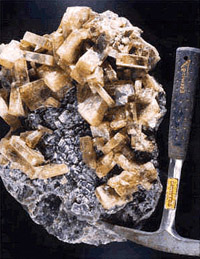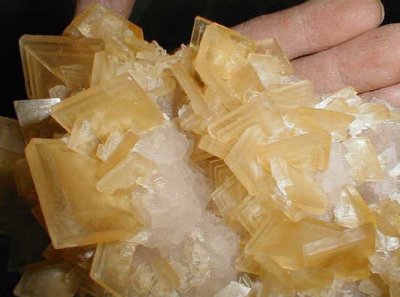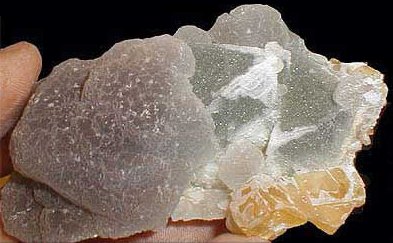
Copyright
The Rock Candy Mine
By Chris J.P. Rylands
If you found a piece of translucent green stone in a mountain creek today, you would probably think that it was a piece of a broken beer bottle. However, over eighty years ago, thanks to a woman named Ruth Stout, she did not. Ruth thought that the piece was jade. She brought it back to town and soon found out that the stone was not jade – it was fluorite. Soon after her discovery, the Rock Candy Mine was born in 1918.
| |

Figure 1. The Rock Candy Mine is known for its barite, fluorite and drusy quartz. In this photograph, green fluorite is overlain by yellow barite crystals.
|
The history and the amount of fluorite which is associated with the Rock Candy Mine is colorful, not to mention the fifty thousand tons of ore that has been stockpiled in the back of the mine since it was first shut down in 1929. However, that material is just that – history, and it is not coming out any time soon. What comes out today is strictly for the mineral collector's display cabinet and not for feeding the super-heated smelting dragons of gold-ore processing plants.
The Rock Candy Mine is located near Grand Forks in British Columbia, Canada. Rockhounds can obtain specimens through collecting trips offered by the mine owner, Bob Jackson. Since 1988, Bob's company, Geology Adventures, has offered a few collecting trips each year to the mine. In summer, 2000, additional trips will be offered in conjunction with the Grand Forks Chamber of Commerce. I have been on a few of these trips with Bob, and they have been exciting and productive. Beautiful plates of fluorite and barite are often extracted from the mine by the mine owner and people who collect at this locality. For example, the miracle of Mother Nature shown below is an example of some of the finest plates of barite crystals the Rock Candy Mine has to offer. The lovely yellow tabular crystals of barite that have grown on the translucent and emerald-green fluorite are the definition of world-class treasures.

Figure 2. One of the finest plates of barite crystals from the Rock Candy Mine. Truly a beautiful miracle of Mother Nature.
The size of the barite crystals that have come out of the mine vary in size and quality. According to the mine owner, the largest known barites that have been extracted from this mine (about four inches tall) are on public display at the Pacific Mineral Museum in Vancouver, British Columbia. Some plates of these crystals have weighed up to one hundred fifty pounds. It is also said that in the early years of the mine, some barite crystals up to eight inches in length from end to end were found. Although the barites shown in the mine owners hand below are much smaller, opaque, and are less delicate than the ones shown in the above photo, they are no less remarkable geological treasures that any mineral collector would prize.

Figure 3. Cluster of barite crystals.
Mother Nature has been very creative with her arrangement of the available minerals at this unique locality. Sometimes a collector will extract a representative plate of minerals that reflect all the colors, crystal forms, mineral types, and purities that the Rock Candy Mine can offer. For example, the plate shown below has botryoidal purple fluorite on the left side of the plate, two large green pyramidal crystals of fluorite in the center that are frosted with a twinkling druzy quartz, and on the lower right, the plate enjoys some butterscotch-colored barite crystals hanging on for the ride. When this plate is illuminated from underneath, the three colors become rich and vivid. This specimen is truly a lucky and remarkable coincidence of mineral color, shape, and variety.

Figure 4. Fluorite plate, with yellow barite crystals attached at bottom right. This specimen is a typical example of the variety of colors, crystal forms, mineral types, and purities found in specimens from the Rock Candy Mine.
Now you have an idea as to what can be found at the Rock Candy Mine. The specimens from this locality are truly unique and a delight for the serious mineral collector. With a little luck, patience, and some hard and careful work, you may be able to find some of these fantastic fluorite, barite and drusy quartz specimens.
Geology Adventures allows collecting at the Rock Candy Mine during the summer on a per fee basis. In June 2000, Chamber of Commerce in Grand Forks will offer collecting trips three days a week. Guided trips will be held on Fridays, Saturdays and Sundays. For more information, visit Geology Adventures online at geologyadventures.com, or contact Bob by
e-mail at geologyadventur@seanet.com.
Additional Information
- The Rock Candy Mine
Visit this web page to learn more about the Rock Candy Mine, its minerals, and its history.
References
- Government of British Columbia, Ministry of Energy & Mines. MinFile Production Report: 082ESE070. 1999.
- Bob Jackson. Owner of the Rock Candy mine and a number of mineral claims. Bob has written gold panning and prospecting books along with the four volumes of The Rockhound's Guide to Washington. He also teaches courses related to geology and provides rockhounding trips across the state and other locations around the world through his company Geology Adventures.
Copyright © 2000 Chris J.P. Rylands
E-mail: crylands@u.washington.edu
Website: Washington State Rockhounding
Permission is given to freely reprint this article from the Canadian Rockhound for non-commercial and educational purposes, provided the author and the Canadian Rockhound are acknowledged, and that the website URL address of the Canadian Rockhound is given. The article may not be edited or rewritten to change its meaning or substance without the author's permission. To contact the author, please use the e-mail address provided.
More on Copyright






